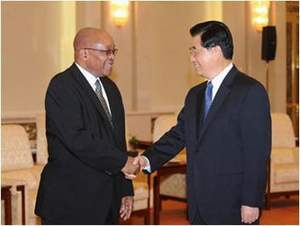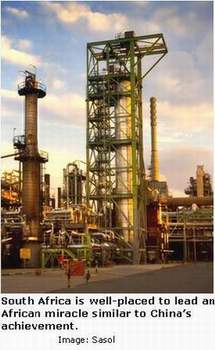 ReConnect Africa is a unique website and online magazine for the African professional in the Diaspora. Packed with
essential information about careers, business and jobs, ReConnect Africa keeps you connected to the best of Africa.
ReConnect Africa is a unique website and online magazine for the African professional in the Diaspora. Packed with
essential information about careers, business and jobs, ReConnect Africa keeps you connected to the best of Africa.


 The shift in focus by South Africa to building partnerships with emerging economic powers has the potential to transform trade with Africa, says John Battersby
The shift in focus by South Africa to building partnerships with emerging economic powers has the potential to transform trade with Africa, says John Battersby
As the shift in global economic power gains momentum, South Africa's trade is moving eastwards and southwards in what has become a clear pattern which both reflects the global trend and is helping drive it.
It is no coincidence that since the beginning of the year, South Africa's President Jacob Zuma has paid his first State visits to India, Russia and China and, in July. Brazil's President Luiz Inacio Lula da Silva paid his first State visit to South Africa following a working visit by President Zuma earlier in the year.
Earlier this year China officially became South Africa's largest two-way trading partner and, just before the State visit to China in August, China became the world's second largest economy after the United States.
On a visit to China earlier in the year, the South African Minister of International Relations and Co-operation, Maite Nkoana-Mashabane, let it be known that South Africa was actively lobbying China to become part of the global club of high-growth developing markets known as BRIC – Brazil, Russia, India and China.
While there is no timeframe for South Africa to become part of BRIC, the symbolism is clear and underscores South Africa's significance as a leader on the African continent and a solid bridge between the industrialised and developing worlds.
Even the notion that the much smaller South African economy could join four mega-economies in BRIC clearly reflects growing global investor interest in Africa - a continent which is increasingly seen as the last frontier of the global economy.
With a population approaching 1 billion, Africa represents the world's third largest market after China (1.3 billion) and India (1.1 billion) and is rich in largely unexploited mineral and natural resources as well as providing a key link in the chain of climate change.
Africa will need to be at the centre of any global trade-off between the industrialised and developing nations because it contributes least to climate change but stands to lose the most from its potentially devastating impact.
For the past decade or so, South Africa has been participating in regular bilateral meetings with India and Brazil in the IBSA grouping which reflects the key role of the three countries.
All three are leading members of the G20 global group of nations which best reflects the changing world order. The G20 has already partly superseded the G8 industrialised group of nations which is unable to solve the world's mounting problems of poverty, underdevelopment and climate change on its own.
While South Africa's foreign policy clearly is aimed at maintain its substantial trade and investment links with major established markets such as the United States, Japan and the European Union, the reality is that growth in these industrialised markets have been severely slowed by the global economic and financial crisis.
The current consensus on global economic growth puts the high-growth developing economies and the next tier of emerging markets – such as the CIVETS (Colombia, Indonesia, Vietnam, Egypt, Turkey and South Africa) – at the forefront of economic growth as a medium to long-term trend and forecasts sluggish growth in most of the developed economies.
While attending a UN conference on trade and investment in Beijing in mid-September, the South African Trade and Industry Minister Rob Davies said South Africa would prioritise China and India as export destinations of choice as these countries were now its biggest export markets.
This meant that South African companies would have to produce goods and services that would suit the needs of one of the world's most populous nations. He said that “sluggish growth” in the United States and the European Union, South Africa's traditional trading partners, was a factor which contributing towards the shift in the export market.
Two-way trade between China and SA last year reached R119.7 billion, surpassing the US as the country's largest trading partner, according to South Africa's Department of Trade and Industry. SA's exports to India last year reached R 5 billion, while imports totalled R2 billion, in favour of SA, the Department's trade statistics show.
The fundamental shift in South Africa's trading patterns was also clear from statements made by President Jacob Zuma during and after the State visit to China in August.
South Africa would look to China for investment in meeting its infrastructure projects including transport systems, freight transport, renewable energy projects and mining. The agricultural sector and car manufacturing are also potential recipients of Chinese investment.
In the past three years, while the pace of Chinese investment has been slow, it has been strategic and clearly paving the way for accelerated investment in the future.
 In 2007 the Industrial and Commercial Bank of China (ICBC) bought a 20% stake in Standard Bank for R36 billion, making it China's largest foreign investment to date. In 2009, China announced that the African headquarters of the China-Africa Fund would be in Johannesburg.
In 2007 the Industrial and Commercial Bank of China (ICBC) bought a 20% stake in Standard Bank for R36 billion, making it China's largest foreign investment to date. In 2009, China announced that the African headquarters of the China-Africa Fund would be in Johannesburg.
China has more recently invested in a South African platinum mine and a cement factory and one of the most concrete agreements emerging from the State visit to China in August was the intention to build a high-speed rail link between Durban and Johannesburg.
But the most consistent message that President Zuma conveyed in the State visits to China and Russia was that South Africa wanted to learn from both countries on how to ensure high levels of beneficiation of South African mineral wealth to ensure that the country was able to speed up development, create more jobs and roll back poverty.
President Zuma also stressed that South Africa needs to balance its trade with China to reduce the heavy deficit in China's favour. He also foresaw co-operation between the two countries in reforming the global architecture and multilateral institutions.
The growing relationship with China is seen both as a means to boosting South Africa's global trade and of accelerating the development of the Africa continent.
China's most impressive achievement since President Deng Xiaoping began opening its economy in 1979 is that it has lifted 400 million people out of poverty by maintaining growth close to 10% for more than 25 years.
Prioritising the agricultural sector, developing its infrastructure and attracting high levels of foreign investment have been three crucial elements contributing to this astonishing achievement.
With its world-class financial sector, deep experience in African markets and an extensive corporate footprint on the African continent, South Africa is well-placed to lead an African miracle similar to China's achievement over the past 30 years.
John Battersby is UK Country Manager of the International Marketing Council of South Africa.
